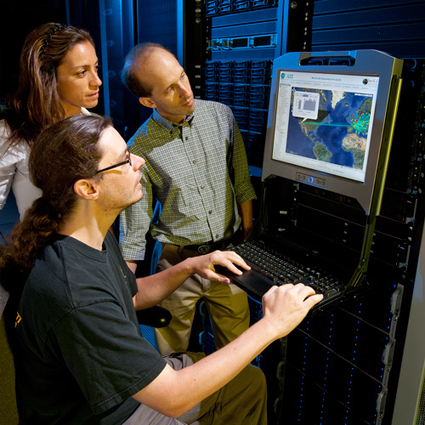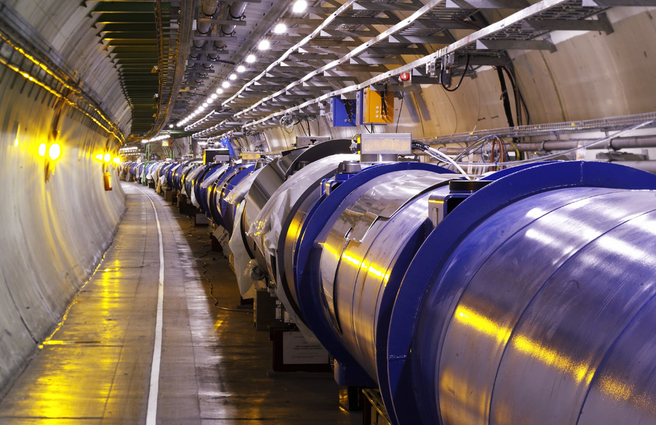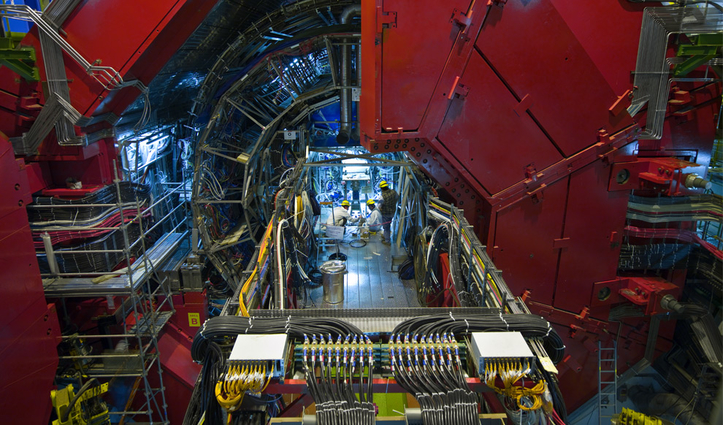ALICE provides looking glass to birth of cosmos
Lab physicist Ron Soltz is part of an international team seeking to go back in time 14 billion years to the origins of the universe. In what would have been science fiction not so long ago, scientists may now have the means to time travel experimentally — the Large Hadron Collider (LHC) particle accelerator at CERN in Switzerland.
Soltz and LLNL colleagues have been involved in the design and now the operation of "A Large Ion Collider Experiment," or ALICE, one of the four principal particle detector experiments on the LHC accelerator, a 17-mile-long magnetic ring that can smash particles together at the highest energy ever achieved. Massive particle detectors record and analyze the collision debris as part of an effort to better understand the origins and the very substance of the universe (see the related story).
"We are recreating what the universe looked like microseconds after the Big Bang," said Soltz, who serves as the computing coordinator for the DOE Office of Science, funded institutions in ALICE. "And creating the hottest, densest matter ever; the heaviest atoms at the highest energy.
"To figure out what happened requires collecting and analyzing enormous amounts of data from the experiment and to do this we need a lot of high-performance computing power," he said.
LLNL has partnered with Lawrence Berkeley Laboratory's National Energy Research Scientific Computing Center (NERSC) to create a Tier-2 U.S. site on the grid to manage storage and processing of experimental data from ALICE. In a project funded by DOE Nuclear Physics Office, LLNL and LBL are providing the primary computing and storage resources for ALICE collaborators in North and South America. These computing resources are being made available to the more-than 1,000 collaborators worldwide using the ALICE Grid.
ALICE is the only one of the four experiments that was built especially to measure the collisions of lead ions that will occur during one month out of every year. The data collected from the proton collisions during the remaining LHC running will be used by ALICE to perform baseline measurements in contrast to the other LHC experiments that will be searching for the Higgs particle and physics beyond the standard model. ALICE will collect some 10 terabytes of data per day, 10 percent of which will be transmitted from Switzerland to LLNL and LBNL's NERSC over DOE's Energy Science Network (ESnet).
LLNL's ALICE cluster, installed in September, is called the Green Linux Compute Cluster, or GLCC, and is on Livermore Computing's special 10-gigabytes-per-second collaboration network that also houses the Green Data Oasis. The compute nodes are from Dell — they're basically identical to Sierra nodes, but without any interconnects — and the storage is from SuperMicro. The system totals about 10 teraFLOP/S (trillion floating point operations per second). This cluster is now the third largest cluster in ALICE as measured by jobs completed per 24-hour period, and the associated 650-terabyte storage element used to store processed data is among the most heavily used. The cluster is currently processing a final round of simulations in preparation for the first heavy-ion collision data expected in November.
"LHC experiments such as ALICE generate so much data it is not possible to store and process it all in one place, so CERN is using the grid to funnel jobs around the world. These experiments require an international collaboration," Soltz said, noting that "Lawrence Berkeley and Livermore laboratories have a history of supporting ALICE science. Researchers from both labs have already collaborated to design and build the experiment's electromagnetic calorimeter detector, and the partnership between NERSC and GCE to provide computing resources is an extension of that tradition."
Livermore will concentrate on analyzing ALICE data and understanding the underlying science. By studying what happens when nuclei of lead atoms smash together at nearly the speed of light, generating mini fireballs orders of magnitude hotter than the core of the sun, scientists hope to recreate the quark-gluon plasma state of matter that first existed nearly 14 billion years ago, just millionths of a second after the Big Bang. Physicists believe this will provide insight into the very nature of the matter that makes up the universe.
"Jeff Cunningham and Jeff Long of Livermore Computing have done an outstanding job getting the Green Linux Compute Cluster up and into production," Soltz said. "This opens a way for us to enter an exciting new realm of physics."
The GLCC represents LLNL's Livermore Computing's first grid computing project involving international collaboration. This was made possible by the Green Collaboration Environment, established for international collaboration, notably the Program for Climate Model Diagnosis and Intercomparison (PCMDI) and Hyperion, the high-performance computing testbed developed in collaboration with industrial partners. GLCC also represents the first time the DOE Office of Science has invested in computing at LLNL.
(Editor's note: Linda Vu of LBL contributed to this article. For more on LBL and ALICE, see the ALICE at LBNL Web page.)
Contact
Don Johnston[email protected]
Related Links
Large Hadron Collidor launches new physics eraALICE at LBNL







